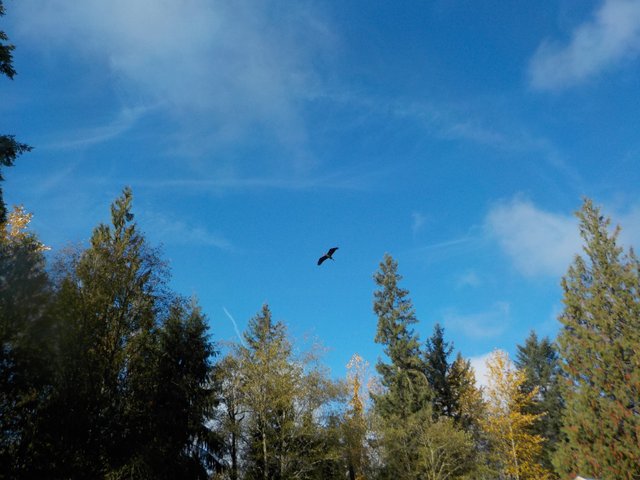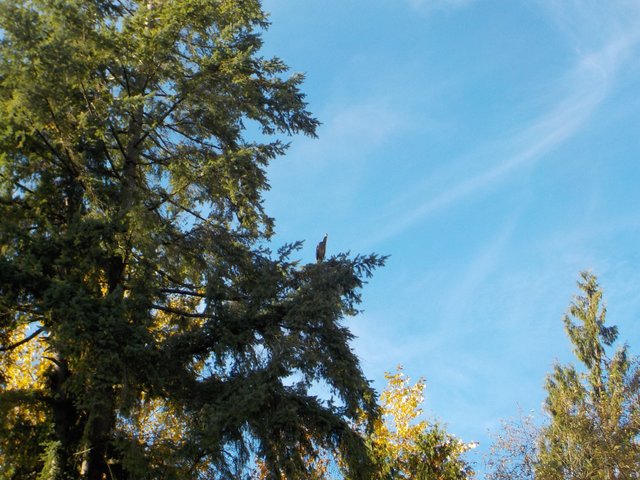
Great Blue Heron has been hanging out around the pond with the Magpie Ducks. The pond was first dug to honor the heron who kept flying over every time a water feature was talked about in the design of our permaculture systems for Leafhopper Farm. This large, beautiful bird has continued to visit and enjoys the pond, even with new residents of the domestic verity.

Heron has eaten many of the fish in the pond, and we’re not sure right now exactly how many are still swimming beneath the surface, but there are enough to continue to tempt this large blue bird in its quest for marine feasts.
Bobcats are a common visitor to Leafhopper Farm, though in this video we get our first glimps of a second pair of eyes shyly peeking out from behind mom. The adult female bobcat is feasting on a gut-pile from the black-tail deer I harvested earlier this fall.
This footage demonstrates a healthy population of wild cats which continues to thrive on the edges of rural human development. Though the farm does loose livestock to these cats periodically; the farm’s philosophy evolves with wildness in mind, sharing space with predator species is as important as cultivating the domestic ones. Stewardship of the landscape does involve trapping and hunting, and a bobcat could be harvested off this land without harming the health of the overall population. Making time to catch a cat in daylight will be challenging, and not a priority on the winter “things to do” list for the farm this year.
The bobcats are bold, and will eventually encroach enough to demand action. This footage was taken about twenty feet from the pond where the ducks are now living. We lost one within days of moving them outside. Now a mesh electric net add a layer of protection, but the bobcats are still too close for comfort. They are beautiful animals, but determined opportunistic predators. Our domestic cats are also threatened by these resident big feline cousins. It might be advantageous to invest in a large live trap in preparation for a needed removal of any problem predator. With a growing flock of chickens, goats that are small enough to make a meal for a bobcat, and ducks, the temptation to begin a string of predation might become too great.
Leafhopper Farm greatly appreciates its wildlife, and will continue to build habitat and space for the wild neighbors of the farm to roam and relax. Our soon to be fenced stream buffer will become the encouraged wildlife corridor along Weiss Creek. We’ll continue to develop wilder buffer areas throughout the property, to allow wildlife places to move through the landscape, preferably in directions which avoid direct encounters with livestock and important crops like orchards and vegetable gardens. With smart planning, the property can facility a coexistence between wild and domestic, bridging the different plant and animal communities in a harmonious way.
Liz Crain
@leafhopperfarm

To learn more about Leafhopper Farm visit us at:
LeafhopperFarm.com, YouTube, Twitter & Minds
Ah, wow, your bobcat footage is very cool. The heron visits us here in Austin, on occasion. Such a big and beautiful bird. Good news: This gem of a post was discovered by the OCD Team!
Reply to this comment if you accept, and are willing to let us share your gem of a post! By accepting this, you have a chance to receive extra rewards and one of your photos in this article may be used in our compilation post!
You can follow @ocd – learn more about the project and see other Gems! We strive for transparency.
If you would like your posts to be resteemed by @ocd and reach a bigger audience, use the tag #ocd-resteem. You can read about it here.
Downvoting a post can decrease pending rewards and make it less visible. Common reasons:
Submit
Those bobcats are coming too close for my personal comfort. We get coyotes and the odd jaguar here. So far so good. No losses yet, but there will come a day and then I will have to live trap and relocate these animals.
Downvoting a post can decrease pending rewards and make it less visible. Common reasons:
Submit
Statistically, relocating an animal does not work well for the animal and they either return, or are out-competed by the resident animals. It's better to harvest the problem animals and prevent stress on the resident animals who receive you're relocated neighbors.
Downvoting a post can decrease pending rewards and make it less visible. Common reasons:
Submit
I hate seeing animals put down...
Downvoting a post can decrease pending rewards and make it less visible. Common reasons:
Submit
Hi! I am a robot. I just upvoted you! I found similar content that readers might be interested in:
https://leafhopperfarm.com/
Downvoting a post can decrease pending rewards and make it less visible. Common reasons:
Submit